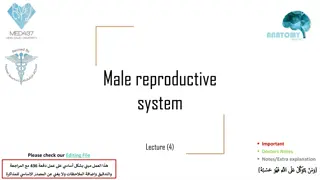Understanding Testicular Tumors: Types, Classification, and Clinical Findings
Testicular tumors are predominantly malignant, with germ cell tumors being the most common type. This article delves into the classification of testicular tumors, including primary and secondary, benign and malignant, germ cell, and non-germ cell tumors. Clinical findings such as painless enlargement of the testis, acute testicular pain, and symptoms related to metastasis are highlighted. Additionally, specific types of tumors like seminoma, embryonal carcinoma, yolk sac tumor, and choriocarcinoma are discussed alongside their pathologic features. Early detection and understanding of testicular tumors can significantly impact patient outcomes.
Download Presentation

Please find below an Image/Link to download the presentation.
The content on the website is provided AS IS for your information and personal use only. It may not be sold, licensed, or shared on other websites without obtaining consent from the author. Download presentation by click this link. If you encounter any issues during the download, it is possible that the publisher has removed the file from their server.
E N D
Presentation Transcript
TESTICULAR TUMOURS PROF. DR. METE K LC LER DEPARTMENT OF UROLOGY, SCHOOL OF MEDICINE, BAH E EH R UNIVERSITY
Tumours of the testis Introduction: Intratesticular - malignant 90-95% germ cell tumors 1-2% Bilateral-lymphoma 7-10% of testis tumors develop in cryptorchidism Orchiopexy does not alter the malignant potential Exogenous estrogen to the mother during pregnancy Survival of patients has improved dramatically
Tumours of the testis Classification: Primary Secondary Benign Malignant Germ cell Non germ cell Germ cell tumors: Seminoma Non-seminomatous: Embryonal Teratoma Choriocarcimoma Mixed tumors
Primary Testicular Cancer GERM CELL Seminoma 35% Classic (85%) Anaplastic (5-10%) Spermatocytic (5-10%) Embryonal 4% Adult type Infantile type (yolk sac tumor) Teratoma 10% Choriocarcinoma 1% Mixed cell type 40% Teratocarcinoma NONGERM CELL Leydig 1-3% Sertoli <1% Gonadoblastoma 0.5%
Embriyonal carcinoma Grossly, the tumors are large, often hemorrhagic and necrotic producing at cut surface.
Pathologic features of yolk sac tumor Gross: The cut surface is gray-white and may be cystic.
Tumors of the testis Clinical findings A-symptoms: Painless enlargment of testis Acute testicular pain (10%) Symptoms related to metastasis (10%): back pain- cough-dyspnea anorexia-nausea- bone pain- lower ext. edema Asymptomatic (10%)
Tumors of the testis Clinical findings B: signs: Testicular mass or diffuse enlargment Node palpation Gynecomastia
Tumors of the testis Laboratory findings and tumor markers: Anemia-increased liver function tests- increased creatinin Tumor markers: AFP -HCG LDH hCG(%) AFP(%) Seminoma Teratoma Teratocarcinoma Embryonal choriocarcinoma 7 0 25 57 60 100 38 64 70 0
Alpha Feto Protein Expressed by the early embryo (also liver and GI tract) Half-life: 5-7 days Produced by pure embryonal, teratocarcinoma, yolk sac, mixed tumors (NOT pure choriocarcinoma or seminoma) Falsely elevated in liver dysfunction, viral hepatitis
Beta Human Chorionic Gonadotrophin Secretory product of the placenta Half-life: 24-36 hours Produced by syncytiotrophoblastic tissue All choriocarcinomas, 60% embryonal, 10% seminoma Falsely elevated in hypogonadism and marijuana use
Lactic Acid Dehydrogenase Presents normally in smooth, cardiac and skeletal muscle, liver and brain Most useful in advanced seminoma or tumors where other markers are not elevated Many false positives
Tumors of the testis Imaging Ultrasonography CT-Scan MR
Risk Factors Cryptorchidism: 7-10% of patients with testicular cancer have a history of cryptorchidism Abnormal germ cell morphology Elevated temperature 5-10% of patients with testicular cancer and a history of cryptorchidism develop cancer in the contralateral testis Orchidopexy does not prevent development of cancer
Risk Factors II Gonadal Dysgenesis 20-30% develop cancer (gonadoblastoma) Trauma Hormones Estrogen in the pregnency Atrophy (nonspecific vs. mumps orchitis) Speculative
Tumors of the testis Differential diagnosis Epdidymitis & Epididymoorchitis Hydrocele Spermatocele Hematocele Granulomatous orchitis Varicocele Epidermoid cyst
Radical Orchiectomy Inguinal approach best way for the surgery Avoid seeding the scrotum and disrupting lymphatics
Tumors of the testis Treatment Inguinal Exploration & radical orchiectomy Low stage seminoma: retroperitoneal irradiation 95% care high stage seminoma: primary chemotherapy 95% complete response A. A.
Tumors of the testis Treament C: low stage NSGCT: Radical orchiectomy 1)Confined within tunica albuginea? 2)Vascular invasion? 3)tumor markers? 4)radiographic imaging?
Tumors of the testis Treatment of high stage NSGCT: primary chemotherapy +RPLND
Tumors of the testis Follow up: every 3 month/ first 2 years every 6 month/ until 5 years and then yearly Careful exam of remaining testis, abdomen, lymph node area tumor marker at each visit. CT every 3-4 month
Tumors of the testis Prognosis Seminoma: R.O+radiotherapy: stage I: 98% 5 years survival rate stage II: 92% 5 years survival rate stage III (chemotherapy): 35-75% NSGCT: stage I: 96-100% low, volume stage II: 90% stage III: 55-80%
Tumors of the testis Secondary tumors of the testis 1. lymphoma : Most common testis tumour in>50 years old 2. leukemia : Testis biopsy is choice 3. metastatic tumor: prostate- lung GI-melanoma-kidney
Tumors of the testis Extragonadal germ cell tumors 3% of all germ cell tumors the most common sites: mediastinum- retroperitoneum, sacrococcygeal pineal gland
Tumors of the testis Tumors of the epididymis, paratesticular tissue & spermatic cord Tumor of epididym: commonly benign: adenomatoid leiomyoma cystadenoma Tumor of spermatic cord: lipoma Rabdomyosarcoma leiomyosarcoma. Fibrosarcoma liposarcoma
Leydig cell tumor key facts: Can develop at any age from infancy to old age Most are benign, some are malign Most tumors are hormonally active, but some are inactive May secrete androgens or estrogens -Androgen excess: Premature puberty & macrogenitosomia -Estrogen excess: Gynecomastia in adult males
Sertoli cell tumor These tumors are more rare than Leydig cell tumors. They elaborate androgens or estrogens. Occasionally, they cause gynecomastia but sexual precocity is infrequent.























